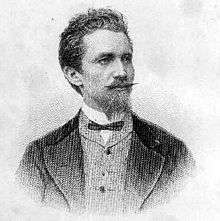Friedrich Gerhard Rohlfs

Friedrich Gerhard Rohlfs (April 14, 1831 – June 2, 1896) was a German geographer, explorer, author and adventurer.
Biography
He was born at Vegesack, now part of Bremen. He was the son of a physician,[1] and there was much pressure on Rohlfs to be in the field of medicine. After the ordinary course at the gymnasium of Osnabrück, he entered the Bremen corps in 1848, and took part as a volunteer in the Schleswig-Holstein campaign, being made an officer after the battle of Idstedt (July 1850).[1] He then became a medical student, and studied at the universities of Heidelberg, Würzburg, and Göttingen. He wanted to travel, joined the French Foreign Legion in a medical capacity, and served during the conquest of Kabylia.[1] He attained the highest rank open to a foreigner,[2] and was decorated for bravery as Chevalier of the Legion of Honour.[1] Having learned the Arabic language and the mode of life of the inhabitants, in 1861 he went to Morocco,[1][2] and was for some time personal physician to a nobleman there.
He then set off on his own, exploring the oases of Morocco. It was on this trip that he was attacked and left for dead, his leg almost severed from his body. These injuries would keep him from returning to Europe for most of his life, the cold weather somehow aggravating them. In 1864 he continued his travels in Morocco, and crossed the Atlas Mountains to the oasis of Tuat. His description and map of the country were the first ever made from personal observation and with scientific knowledge.[2]
After this trip, and a short visit to Germany,[2] Rohlfs returned to Africa, and, disguised as an Arab, was the first European to cross Africa from Tripoli across the Sahara desert via Lake Chad and along the Niger River and to present-day Lagos on the Gulf of Guinea from 1865-1867. He was the second European explorer to visit the region of the Draa River in the south of Morocco. For this work, in 1868 he was awarded the Patron's Medal of the Royal Geographical Society of London.[1] Rohlfs's detailed account of it is contained in the Ergänzungsheft (“Supplement”) No. 34 to Petermann's Geographische Mittheilungen (Gotha, 1872).[2]
At the close of 1867, by order of the king of Prussia, he joined the British punitive expedition to Abyssinia. He returned to Tripoli in 1868, and in 1869 traversed the desert from Tripoli to Alexandria, visiting the oasis of Siwah, site of the ancient city of Ammonium.[2] Returning to Germany, he married and settled down in Weimar.[1]
In 1873, with an expedition of 100 camels and 90 men, organized under the patronage of the khedive of Egypt Isma'il Pasha, he explored the Libyan desert west of the chain of oases which skirt the valley of the Nile, and discovered that the depression called the Bahr Bela-ma (river without water), marked on many maps of the desert at that time, did not exist. In 1874 Rohlfs set out from Dakhla Oasis intending to reach Kufra. In February he was about 100 kilometres (62 mi) north of Abu Ballas (Pottery Hill) in the Western Desert. Accompanied by Karl Zittel and a surveyor called Jordans, Rohlfs and his colleagues experienced a torrential downpour - a rare occurrence in the desert. Rohlf's team restocked and watered their camels and left a cairn at the place he had named Regenfeld (“Rain field”).[3] The progress of the expedition was stopped by hills of loose sliding sand which the camels were unable to traverse, and the party turned back.[2]
In 1875 he visited the United States, and lectured on his travels.[2] In 1878 Rohlfs and Anton Stecker (1855-1888) were commissioned by the German African Society to go to Wadai. They succeeded in reaching the oasis of Kufra, one of the chief centres of the Senussites, but being attacked by Arabs, they were obliged to retreat, making their way to the coast at Benghazi, reached in October 1879. In 1880 Rohlfs accompanied Stecker in an exploring expedition to Abyssinia; but after delivering a letter from the German emperor to the Negus, he returned to Europe.[1]
In 1885, when the rivalry belween the British and Germans in East Africa was very keen, Otto von Bismarck appointed Rohlfs consul at Zanzibar, which island Bismarck desired to secure for Germany. Rohlfs, untrained in diplomacy, was no match for John Kirk, the British agent, and he was soon recalled, and did not again visit Africa.[1]
Rohlfs died at Rüngsdorf, near Bonn.[1]
Bibliography
- Rohlfs, G.F. (1868), Reise durch Marokko, Übersteigung des großen Atlas, Exploration der Oasen von Tafilet, Tuat und Tidikelt und Reise durch die große Wüste über Rhadames nach Tripoli, Bremen: J. Kühtmann.
- Rohlfs, G.F. (1874), Adventures in Morocco and journeys through the oases of Draa and Tafilet, London: S. Low, Marston, Low, & Searle.
- Rohlfs, G.F. (1870), Land und Volk in Afrika: Berichte aus den Jahren 1865-1870, Bremen: J. Kühtmann.
- Von Tripolis nach Alexandria (1871)
- Quer durch Afrika (1874–75)
- Beiträge zur Entdeckung und Erforschung Afrikas (1876)
- Reise von Tripolis nach der Oase Kufra (1881)
- Quid Novi ex Africa (1886)
References
- 1 2 3 4 5 6 7 8 9 10
 Chisholm, Hugh, ed. (1911). "Rohlfs, Friedrich Gerhard". Encyclopædia Britannica (11th ed.). Cambridge University Press.
Chisholm, Hugh, ed. (1911). "Rohlfs, Friedrich Gerhard". Encyclopædia Britannica (11th ed.). Cambridge University Press. - 1 2 3 4 5 6 7 8
 Ripley, George; Dana, Charles A., eds. (1879). "Rohlfs, Gerhard". The American Cyclopædia.
Ripley, George; Dana, Charles A., eds. (1879). "Rohlfs, Gerhard". The American Cyclopædia.
- ↑ W.B. Kennedy Shaw, Long Range Desert Group, Greenhill Books, 2000
- ↑ IPNI. Rohlfs.
External links
- Works by Gerhard Rohlfs at Project Gutenberg
- Works by or about Friedrich Gerhard Rohlfs at Internet Archive
- Gerhard-Rohlfs.de, works by Gerhard Rohlfs